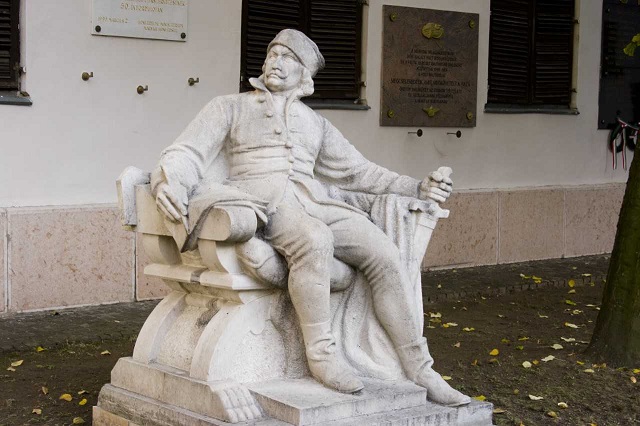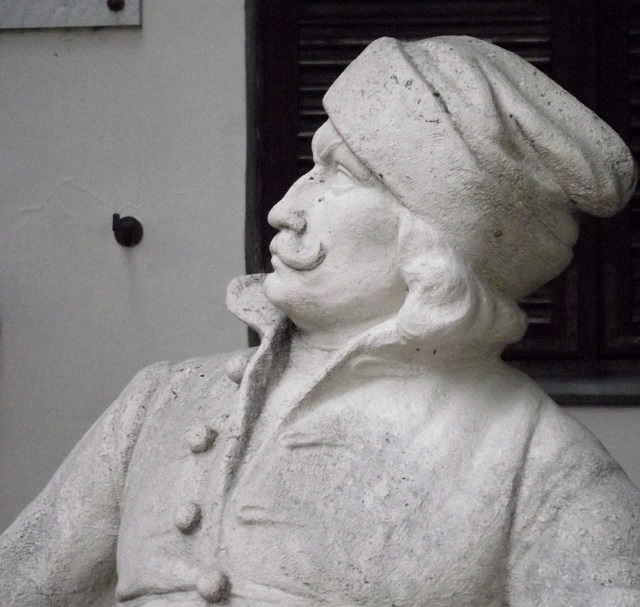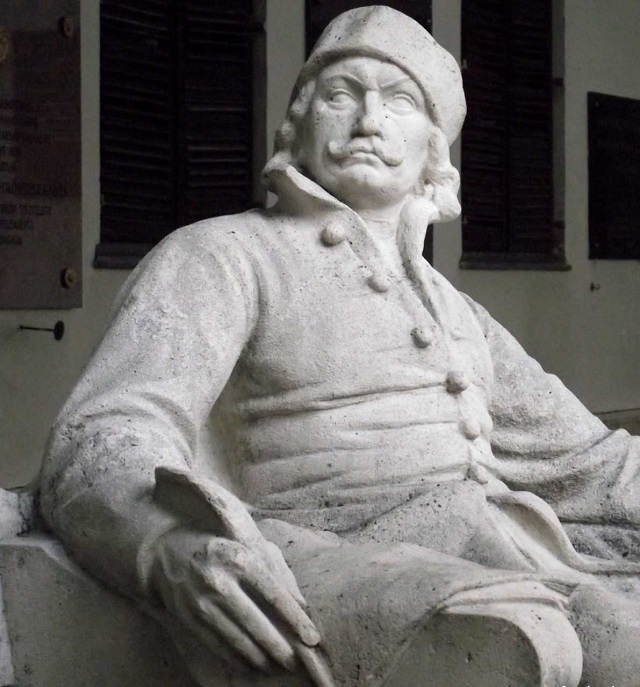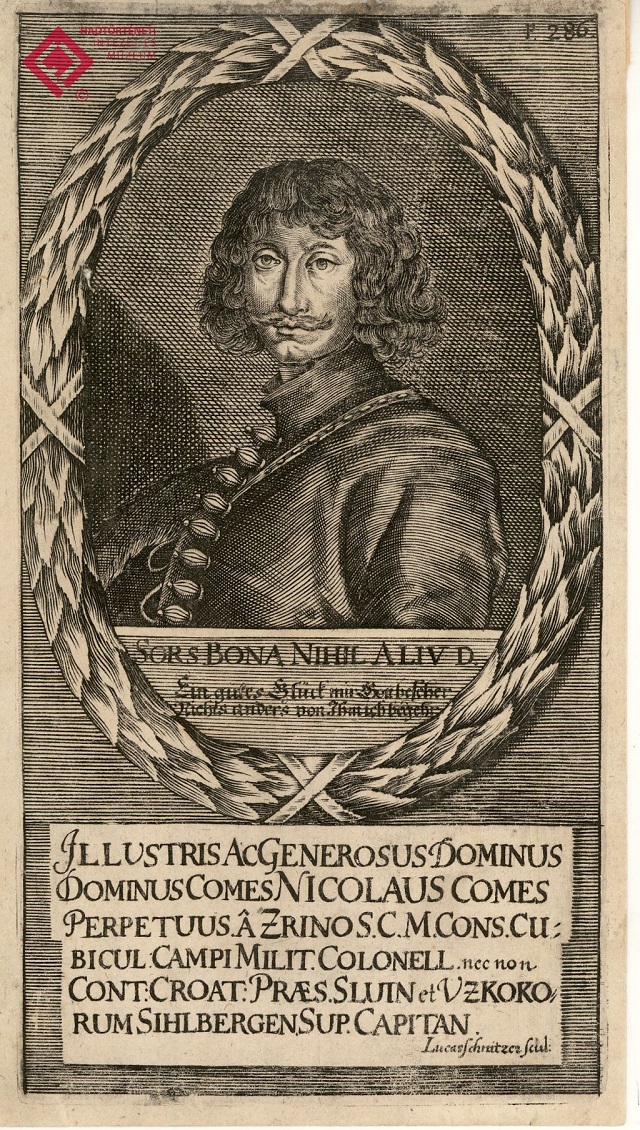Between the two World Wars, the cult of poet and military leader Miklós Zrínyi in military propaganda gained rising significance, which brought the need for sculptures in public places with itself.
The Ministry of Culture entrusted János Horvay (1873-1944), a well-known sculptor of the period, with designing Zrínyi’s sculptures. The expenses of the work were covered by the Ministry of Culture, the Hungarian Parliament and by the council of the capital city.
Horvay created two statues. The standing-figured Zrínyi statue was intended for the main square of Csáktornya (today Čakovec, Croatia), but due to the Second World War it was not erected. In 1964, this sculpture was inaugurated in Szigetvár on the 300th anniversary of the death of the poet and general.
The sitting-figured Zrínyi statue was planned to be placed in the spring of 1943 in front of the Halászbástya (Fisherman’s Bastion) in Budapest, in the street leading from Hunyadi János Road to Buda Castle. However, due to the scarcity of fine stone material and the lack of workforce during the war, works were delayed, and after Hungary lost the war the inauguration was cancelled. The sculpture was stored at the military base on Hűvösvölgyi Road, from where it was moved to the Military History Museum’s courtyard in 2008. The plaster draft of the sculpture is preserved by the Hungarian National Gallery’s Sculpture Collection.



Miklós Zrínyi (Croatian: Nikola Zrinski), the later Croatian ban (governor of Croatia within the Hungarian Kingdom) was born to György Zrínyi and Mária Széchy, according to the latest research results in Csáktornya on 3 May 1620. After the early death of his parents, he and his brother (Péter) were taken under the protection of the court in Vienna, which took care of their education. A four-member committee of appointed tutors looked after the brothers, but in their education the wife of Ferenc Batthyány, the neighbouring estate’s lord and cousin of Zrínyi’s father, also played a major role. Éva Batthyány née Lobkovitz-Poppel acted as the brothers’ foster mother. Later, when the emperor had enough of the appointed tutors’ abuse, gave the rights of tutorship over the brothers to the Archbishop of Esztergom, Péter Pázmány. Thus, the brothers continued their education in a Jesuit college in Graz, after which they went to Vienna, then to Nagyszombat (today Trnava, Slovakia) and then, having finished their studies, they travelled around Italy according to the customs of the day.
Already in 30 December 1637, Miklós Zrínyi became the chamberlain of Emperor Ferdinand III, which marks his ties to the Habsburg court, as he was the youngest among the 17th-century magnates of Hungary who gained this title. As a child he inherited his father’s title of royal horse master. In the spring of 1640, as young as the age of 20, he became the hereditary supreme captain of Muraköz (Međimurje) and Légrád (today Legrad, Croatia), thus he was responsible for two border zones facing the Ottomans.
In 1642-1644, with his Hungarian and Croatian troops he participated in the Thirty Years’ War. As a recognition of his service, he became a Generalfeldwachtmeister (a military rank between a brigadier and a lieutenant general) of the forming standing army of the Habsburgs. According to the latest research results, he was the very first Hungarian aristocrat who gained this rank; thus, he was the first imperial general of Hungarian origin.
At the turn of 1647-1648, he ‘inherited’ his father’s and grandfather’s title of Croatian ban. In 1659, Zrínyi was also appointed as secret counsellor, which means he became a member of the highest advisors’ board of the Habsburg Monarchy, as one of the first such Hungarians who had not acquired the palatine’s office of the Hungarian Kingdom beforehand.
Zrínyi did not only defend his country with arms, but he tried to organise a supportive society on which he could build on an anti-Ottoman movement, as the Habsburg court was lacking any clear political aim to repel the Turks from the occupied Hungary. Therefore the main aim of Zrínyi’s political agenda was to organise the defence against Ottomans. The summary of his experience in military leadership was reflected by the theoretical works titled ‘Tábori kis trakta’ (A Little Military Treatise) and ‘Vitéz hadnagy’ (The Valiant Lieutenant). His essay on King Mathias’ life was a discourse on the topic of state theory, which contained his critics about the Habsburg rule too. His major poetical work was on his grandfather’s (also named Miklós Zrínyi) heroic but tragic defence of Szigetvár against Sultan Suleiman I in 1566, titled ‘Szigeti veszedelem’ (The Peril of Sziget) written similarly to Homer’s Iliad.
After the failed campaign of 1657 in Poland by Prince of Transylvania György II Rákóczi, the Ottoman Empire turned towards the west and saw the time fit for a campaign against the Habsburgs. Zrínyi’s anti-Turkish actions and the establishment of a fortress (Zrínyi-Újvár) on an Ottoman-ruled land served as excuses for that. So in 1663, Köprülü Fazıl Ahmed Grand Visier led his army against Hungary and took the city of Érsekújvár (today Nové Zámky, Slovakia) filled with munitions, where the Ottomans established a new vilayet (a Turkish province), then he returned to Belgrade for the winter. Zrínyi took advantage of this and he advanced deep into Ottoman-ruled Hungary, reached Pécs, then with his own men he set fire on the bridges of Eszék (today Osijek, Croatia), which burned for days.
However, the campaign had not reached its original goal because the Ottomans were able to manoeuver through the war-torn country, relieved the besieged Kanizsa and took and demolished the fortress of Zrínyi-Újvár. This was due to the decisions of the imperial high command in Vienna which wanted to avoid any decisive battle against the Ottoman forces from fear of high losses. Therefore the imperial forces were withdrawn and the ban was left alone, who in the meanwhile was inducted into the Order of the Golden Fleece by Spanish King Philip IV, whereas membership had been restrained in Hungary only to palatines.
After that, the Ottoman army reached the river Raab, where on 1 August 1664, at Szentgotthárd the Christian forces defeated the Ottomans causing heavy losses to the sultan’s troops, thus giving hopes for the possibility to repel the Ottomans from the country. The hurriedly ratified peace treaty of Vasvár caused bewilderment and repugnance in Hungary against the Viennese court, also reported by foreign correspondents who were convinced that Zrínyi would be the future leader of resistence in Hungary. But fate intervened when Ban Zrínyi became victim of a hunting accident in the forests of Kursanecz on 18 November 1664.
Initiated by the Hungarian Ministry Of Defence, the Hungarian Parliament announced the year of 2020 a Zrínyi Memorial Anniversary.




